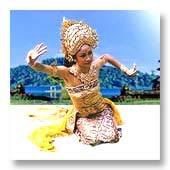In accordance with Usaba Sambah series of ceremony (a month-long series of ceremonies which is held in the fifth month of Tenganan calendar) that is held in the ancient village of Tenganan, a special ceremony for the youth known as Muran Teruna is held. This ceremony is held once every three years which includes several of activities conduct by the youths of three sub-villages in Tenganan.
The word “muran teruna” consists of the word “muran” which derived from the word “uran” means “participant of activity” and the word “teruna” which means “youth.” In the Muran Teruna ceremony, each sub-village sends its maidens to be chosen by its own bachelors as a partner to participate in the series of the ceremonies which will last until late at night.
The ceremony usually begins late in the afternoon with gifts exchange between the three sub-village of Tenganan (Patemu Kaja, Patemu Tengah, and Patemu Kelod). The main gift is called “Bungan Base” or “flower of Base plant.” It is a kind of decoration made of beautifully cut young coconut leaves with flower and butterfly-shaped gold decoration on the top. The additional gift is a kind traditional food placed on banana leaf. After give exchange ceremony is over, the bungan base is placed in front of the sub-village meeting hall with other additional decoration such as mirror or lion statue.
The ceremony is continued with “matabuh” activity in which two bachelor spill a small amount of liquor to the ground accompanied by Selonding orchestra. After the patabuhan ceremony is over, the bachelors and the maidens gather in their respective sub-village meeting hall, two representations of the bachelor party give a present of small amount of liquor to the representations of the maiden party who seated on the swing which is erected near the meeting hall, the maiden representations receive the gift and drink it ceremoniously and spill the rest of the liquor to the ground.
After this, the bachelors sit in a row on the ground in front of the meeting hall. The bachelors are given a small amount of liquor to be drunk, after drinking the liquor the bachelors unsheathe their respective Kris and hold it in front of their chests still in cross-legged sitting position. The maidens are also given a small amount of liquor to be drunk ceremoniously and a small offering is put on each maidens crown then the maidens go up inside the meeting hall and stand there.
One by one, after giving a present of offering to an official the maidens step down to the ground and dance the abuang dance in turn accompanied by selonding orchestra. They dance in front of the decorations which are placed in front of the meeting hall, when the dance is over the maiden retreat to left side of the decoration, watching their friend performance. When the abuang dance session is over, the bachelor sheathe their kris and stand up, then the maidens stand in a row on the left side of the decoration and the bachelor stand on the right side.
Two representations of the maidens go to the swings and sit there and two representations of the bachelors stand on the either side of the swings. They perform a symbolic swinging activity three times, and then they retreat to their respective line. Then the maidens and the bachelors walk circling the grand swing and the decoration in opposite direction. After circling the swing and the decorations three times they move to another meeting hall to perform exactly the same series of ritual except the exchange of the gifts.
Since there are three meeting halls, there will be three groups of youth (each group consist of a band of maidens and a band of bachelors). Each group perform the first series of ceremonies in its respective meeting hall for example the patemu kaja group hold the first series of ceremonies in its own meeting hall and the second series of the ceremonies in the patemu tengah meeting hall, and the third series in the patemu kelod; the patemu tengah group also hold the first ceremony in its own meeting hall and the second and the third series of ceremonies in other groups meeting halls. The groups swap the place so each group will perform the series of the ceremonies in three meeting hall.
There are also several branches of various fruit plants complete with their fruits called “tetubuhan” planted in each meeting hall as a gift for the group of maidens and bachelors from other meeting halls to be picked.
After the groups of maidens and bachelors finish their performance in other meeting halls, the come back to their respective meeting hall and hold a meeting (pesangkepan) there as the conclusion of the Muran Teruna series of ceremony. (BaliWWW)












